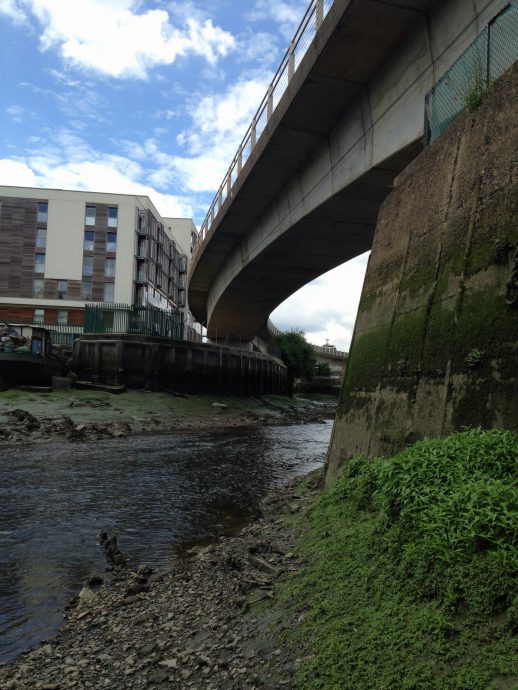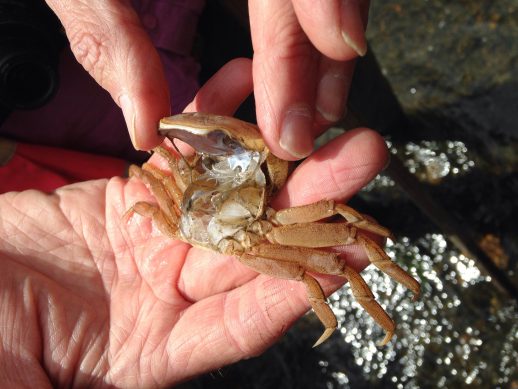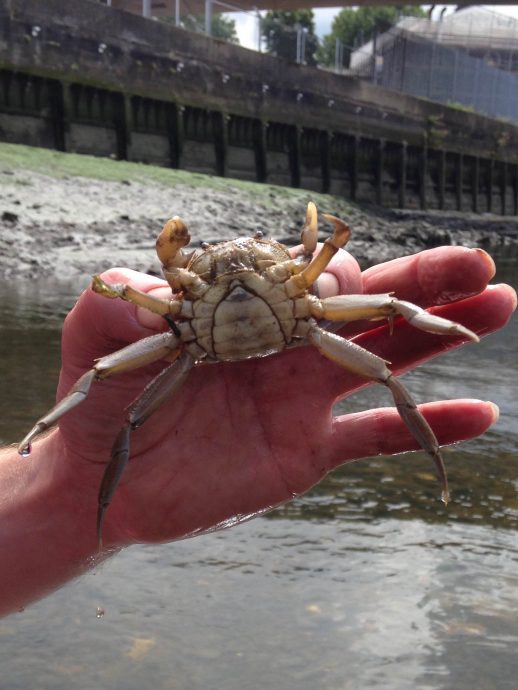Miranda Cichy encounters Chinese mitten crabs, waterlogged iPads and supermarket trollies as she explores the tidal reach of the River Ravensbourne

Deptford Creek does not really exist. It’s the name by which the tidal reach of the River Ravensbourne is known, a kilometre of river bed only exposed when the water drops. The surrounding area, Deptford, takes its name from these tides: “Deep Ford”. Once home to a naval dockyard, Deptford’s wharfs now lie empty, derelict. The river itself is barely a foot deep at low tide, revealing banks of dark ooze and embedded shopping trolleys curtained in slime. On hot days the mud glitters, its tang of fish guts and saltwater steaming up towards the footbridge that connects Deptford to its more illustrious neighbour, Greenwich. It used to be a toll bridge, costing a ha’penny to cross: a concept that we find difficult to imagine today. Perhaps, now that the UK has voted to leave the European Union, we will begin to be more aware of borders, more grateful when we have the freedom to cross them.
Having passed over the bridge countless times, it felt odd to be standing 15 feet beneath it in the creek. It was two days after the EU referendum. Thigh-high wading boots had trapped the heat of a muggy June day, but could not mask the coolness of water now flowing indifferently past my ankles. Around me, the group of fellow waders shifted their feet to test the balance of the riverbed. Heavy storms across London had swollen the river several days earlier but also acted as a cleanser, flushing out mud from the banks and water. Despite the translucent flow beneath my feet, it was hard to imagine that the creek was home to 120 different fish species and 150 plants. The collection of objects at the Creekside Discovery Centre had revealed it to be a home to mobile phones, laptops, lighters, plastic toys – more like a museum of the twenty first century rather than a successful habitat for wildlife.
The low-tide walks happen monthly, led by Nick, Deptford resident for 40 years and owner of a wiry beard that flows to his collar. As he led us upstream towards Lewisham, Nick had a grace in the water that none of our group could match, the river urgent as a crowd as it pushed past our legs. We used shoulder-high poles to test the depth in front of us, but despite this and the relative clarity of the water it was still impossible to know how far the wading boot would sink or whether your foot would slip on loose stones.
At the front of the group, Nick suddenly plunged a hand in the water and came up with a crab pinched between his fingers. As he dropped the crab onto his palm, its orange legs flopped passively. “Is it dead?” asked one of the group. “Alive?” Nick smiled. “The question is… where is the crab?” He gently lifted up the back of it like a trapdoor to reveal an empty interior. Dead or alive, the crab certainly wasn’t in his palm. It had slipped out, leaving behind a perfect exoskeleton.

A Chinese mitten crab. The name comes from its furry claws, designed for burrowing. The mitten crab’s native home is 6,000 miles from Deptford in southern China, where it lives in coastal estuaries. They travelled to the UK originally as stowaways, their larvae swept into the ballast tanks of ships, where they survived the long journey from east Asia to Europe. And they found themselves unwelcome. Their burrowing damages river embankments. They steal bait from anglers, and compete for food with native crayfish. In China the crab is eaten as a delicacy, sold in vending machines in little plastic containers in a state of hibernation. In 2009 a recipe for “Mitten Crab Soup” appeared in The Independent as a suggestion of how in the UK we might reduce and make use of this invasive species, but in south-east London it does not yet seem to have caught on.
Nick flipped the crab on its back to show us its abdomen. The narrow outline of a bell showed that this was a male: females have a broader abdomen to protect their eggs. I wondered where the crab was now. He would have swollen up to expand his shell, extracted himself carefully and slipped out and away into the river: soft, dark and vulnerable. For now, there were no live crabs to be seen, only a beached iPad, water bubbling under the screen like a lava lamp. The boats moored on the bank were silent, although pot plants and flags on the connecting jetties showed that the community was very much alive. Above them, the DLR swung round a corner on its journey towards East London.
Deptford is changing. Having economically declined in the early twentieth century with the closure of its dockyard, it now finds itself on the way up with the rest of London. New housing projects are planned under the concept of ‘regeneration’, a term that masks what it will mean for current residents and local businesses. They will be ‘regenerated’ out with the arrival of rent rises, and a new community that demands high street chains. As we came back downstream and passed under the footbridge, Nick lamented this change: not only for himself, but for the wildlife. The riverbank may be protected, but flats shooting up around it still affect its residents. Although we were not quite at the end the creek, Nick made us stop so as not to disturb the nesting sand martins. The walls they build their homes on are not large enough to establish a proper colony, and only two pairs had been seen this year. Imminent building work around them will no doubt disturb future generations.
And yet the human and non-human communities still find some way to co-exist. Nick pointed out a well-rusted shopping trolley embedded in the middle of the river and furred with weeds. He explained that while the Creekside Centre seeks to remove the majority of the trolleys, some are left. These provide smaller fish with escape routes that they have lost through the removal of vegetation – for while a small fish can slip through the gaps in a trolley, a larger fish in pursuit cannot, and loses its prey. A quick sweep of the riverbed with a net revealed some of the smaller fish within the creek: little flounders, slipping swiftly across the larger rocks, leeches shrinking into themselves, tiny shrimp. An eel escaped the net while a female Chinese mitten crab – this one alive – frothed in fury at being held aloft to a group of waders before we let her continue her day.

The Chinese mitten crab is far from the only invasive species in the creek. The golden stars of narrow-leaved ragwort, a South African migrant, have only been lining the walls alongside the river since the early 2000s. Unlike the crab and the new housing developments in Deptford, the ragwort poses no obvious threat to the environment. Its arrival simply marks time, rather than change. But the awareness of yet another shift in the landscape made me think of the opening lines of ‘Sea Poem’ by Alice Oswald:
What is water in the eyes of water loose inquisitive fragile anxious
In the creek, with water hurrying around me, I could feel what Oswald meant in three of those last four words. Anxious? Not quite. Despite the evolvement of the landscape and species around it, the water continued its journey regardless. We waders were uncertain as to what the future would hold for Deptford Creek, an area that still only really exists in name. For the water, its speed and pull towards the Thames would always be inevitable.